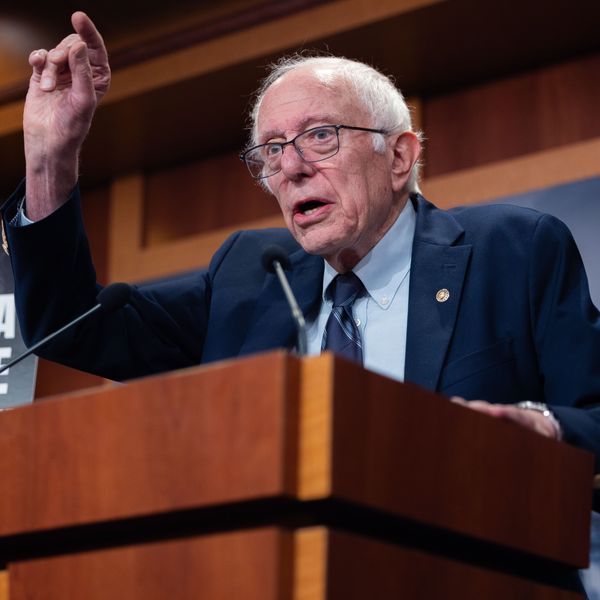How to Cover Everyone: Vermont's Single-Payer Success
The state’s progressive health care model has already bolstered campaigns in more than 20 other places.
The activists who celebrated the passage of Act 48 in Vermont last May will be the first to tell you that there is still a long road ahead. It may be six years before universal, single-payer health care will be fully implemented in the state. That's plenty of time for likely opponents, including the insurance and pharmaceutical industries, to marshal their forces and try to stop it. But the progress in Vermont has bolstered single-payer campaigns in 20-plus states around the country, and successes elsewhere may in turn help sustain Vermont's reform campaign.

Single payer, or "Medicare for all," is universal health care coverage with the government as insurer. (It's not "socialized medicine" as in the United Kingdom, where the government runs hospitals and employs doctors directly.)
President Barack Obama's big push for national health care reform in 2009-2010 left single-payer off the table.
Reform took a different path in Vermont. In 2010, the state hired a Harvard economist to recommend a cost-conscious system of universal coverage. The result, unveiled in early 2011, was a single-payer plan to be run by an independent, quasi-governmental board, with private insurers' role limited to contracts for claims processing and other administrative tasks.
In the meantime, Vermonters elected a strong single-payer supporter, Peter Shumlin, for governor. But the state had seen good single-payer plans and supportive governors before (think Howard Dean). One difference this time around was a huge popular mobilization. As the legislature deliberated, supporters of single-payer turned out in large numbers, including a "People's Team" clad in bright red T-shirts that became a fixture at the State House. The Vermont Workers Center, which had been working to build grassroots support on the issue for two decades, can take a lot of the credit. "It would be a shame," the center's James Haslam emphasized, "if the lesson people took from Vermont was that the win here was all about having ... a sympathetic governor."
Progressive Party State Rep. Chris Pearson says organizing was critical to convincing "nervous Democrats" to support Act 48, and notes that the campaign also benefited from Vermont's progressive political climate. Vermont Businesses for Social Responsibility, an influential alternative to the Chamber of Commerce, supported single payer. Vermont's Blue Cross Blue Shield, the largest insurer in the state and one of the few "Blues" that is still a nonprofit, did not mount an anti-reform campaign. And the presence of the Progressive Party itself made a difference. "While our numbers are small--five out of 150 in the House--our unwavering support for single payer has pulled the debate to the left the way you see the Tea Party pull the debate to the right," Pearson says. He also claims the Progressive Party influenced the Democrats' choice of Shumlin in 2010 by promising not to run a Progressive gubernatorial candidate so long as the Democrats nominated a strong single-payer advocate.
The work of implementation is now under way. The Green Mountain Care Board is holding public meetings around the state as it begins designing the new system and proposing how to finance it. Ironically, meeting the mandates of the federal Affordable Care Act will represent a detour on Vermont's road to universal coverage.
Heavy national players opposed to single payer haven't been active in Vermont yet, at least not openly. Fierce battles probably lie ahead, but the single-payer camp can already claim one victory. Fletcher Allen Health Care, a nonprofit hospital, wanted to sell five dialysis units to a private corporation, Bio-Medical Applications. Single-payer advocates saw this as a step backward, fought hard to prevent the sale--and won.
An Urgent Message From Our Co-Founder
Dear Common Dreams reader, The U.S. is on a fast track to authoritarianism like nothing I've ever seen. Meanwhile, corporate news outlets are utterly capitulating to Trump, twisting their coverage to avoid drawing his ire while lining up to stuff cash in his pockets. That's why I believe that Common Dreams is doing the best and most consequential reporting that we've ever done. Our small but mighty team is a progressive reporting powerhouse, covering the news every day that the corporate media never will. Our mission has always been simple: To inform. To inspire. And to ignite change for the common good. Now here's the key piece that I want all our readers to understand: None of this would be possible without your financial support. That's not just some fundraising cliche. It's the absolute and literal truth. We don't accept corporate advertising and never will. We don't have a paywall because we don't think people should be blocked from critical news based on their ability to pay. Everything we do is funded by the donations of readers like you. Will you donate now to help power the nonprofit, independent reporting of Common Dreams? Thank you for being a vital member of our community. Together, we can keep independent journalism alive when it’s needed most. - Craig Brown, Co-founder |
The activists who celebrated the passage of Act 48 in Vermont last May will be the first to tell you that there is still a long road ahead. It may be six years before universal, single-payer health care will be fully implemented in the state. That's plenty of time for likely opponents, including the insurance and pharmaceutical industries, to marshal their forces and try to stop it. But the progress in Vermont has bolstered single-payer campaigns in 20-plus states around the country, and successes elsewhere may in turn help sustain Vermont's reform campaign.

Single payer, or "Medicare for all," is universal health care coverage with the government as insurer. (It's not "socialized medicine" as in the United Kingdom, where the government runs hospitals and employs doctors directly.)
President Barack Obama's big push for national health care reform in 2009-2010 left single-payer off the table.
Reform took a different path in Vermont. In 2010, the state hired a Harvard economist to recommend a cost-conscious system of universal coverage. The result, unveiled in early 2011, was a single-payer plan to be run by an independent, quasi-governmental board, with private insurers' role limited to contracts for claims processing and other administrative tasks.
In the meantime, Vermonters elected a strong single-payer supporter, Peter Shumlin, for governor. But the state had seen good single-payer plans and supportive governors before (think Howard Dean). One difference this time around was a huge popular mobilization. As the legislature deliberated, supporters of single-payer turned out in large numbers, including a "People's Team" clad in bright red T-shirts that became a fixture at the State House. The Vermont Workers Center, which had been working to build grassroots support on the issue for two decades, can take a lot of the credit. "It would be a shame," the center's James Haslam emphasized, "if the lesson people took from Vermont was that the win here was all about having ... a sympathetic governor."
Progressive Party State Rep. Chris Pearson says organizing was critical to convincing "nervous Democrats" to support Act 48, and notes that the campaign also benefited from Vermont's progressive political climate. Vermont Businesses for Social Responsibility, an influential alternative to the Chamber of Commerce, supported single payer. Vermont's Blue Cross Blue Shield, the largest insurer in the state and one of the few "Blues" that is still a nonprofit, did not mount an anti-reform campaign. And the presence of the Progressive Party itself made a difference. "While our numbers are small--five out of 150 in the House--our unwavering support for single payer has pulled the debate to the left the way you see the Tea Party pull the debate to the right," Pearson says. He also claims the Progressive Party influenced the Democrats' choice of Shumlin in 2010 by promising not to run a Progressive gubernatorial candidate so long as the Democrats nominated a strong single-payer advocate.
The work of implementation is now under way. The Green Mountain Care Board is holding public meetings around the state as it begins designing the new system and proposing how to finance it. Ironically, meeting the mandates of the federal Affordable Care Act will represent a detour on Vermont's road to universal coverage.
Heavy national players opposed to single payer haven't been active in Vermont yet, at least not openly. Fierce battles probably lie ahead, but the single-payer camp can already claim one victory. Fletcher Allen Health Care, a nonprofit hospital, wanted to sell five dialysis units to a private corporation, Bio-Medical Applications. Single-payer advocates saw this as a step backward, fought hard to prevent the sale--and won.
The activists who celebrated the passage of Act 48 in Vermont last May will be the first to tell you that there is still a long road ahead. It may be six years before universal, single-payer health care will be fully implemented in the state. That's plenty of time for likely opponents, including the insurance and pharmaceutical industries, to marshal their forces and try to stop it. But the progress in Vermont has bolstered single-payer campaigns in 20-plus states around the country, and successes elsewhere may in turn help sustain Vermont's reform campaign.

Single payer, or "Medicare for all," is universal health care coverage with the government as insurer. (It's not "socialized medicine" as in the United Kingdom, where the government runs hospitals and employs doctors directly.)
President Barack Obama's big push for national health care reform in 2009-2010 left single-payer off the table.
Reform took a different path in Vermont. In 2010, the state hired a Harvard economist to recommend a cost-conscious system of universal coverage. The result, unveiled in early 2011, was a single-payer plan to be run by an independent, quasi-governmental board, with private insurers' role limited to contracts for claims processing and other administrative tasks.
In the meantime, Vermonters elected a strong single-payer supporter, Peter Shumlin, for governor. But the state had seen good single-payer plans and supportive governors before (think Howard Dean). One difference this time around was a huge popular mobilization. As the legislature deliberated, supporters of single-payer turned out in large numbers, including a "People's Team" clad in bright red T-shirts that became a fixture at the State House. The Vermont Workers Center, which had been working to build grassroots support on the issue for two decades, can take a lot of the credit. "It would be a shame," the center's James Haslam emphasized, "if the lesson people took from Vermont was that the win here was all about having ... a sympathetic governor."
Progressive Party State Rep. Chris Pearson says organizing was critical to convincing "nervous Democrats" to support Act 48, and notes that the campaign also benefited from Vermont's progressive political climate. Vermont Businesses for Social Responsibility, an influential alternative to the Chamber of Commerce, supported single payer. Vermont's Blue Cross Blue Shield, the largest insurer in the state and one of the few "Blues" that is still a nonprofit, did not mount an anti-reform campaign. And the presence of the Progressive Party itself made a difference. "While our numbers are small--five out of 150 in the House--our unwavering support for single payer has pulled the debate to the left the way you see the Tea Party pull the debate to the right," Pearson says. He also claims the Progressive Party influenced the Democrats' choice of Shumlin in 2010 by promising not to run a Progressive gubernatorial candidate so long as the Democrats nominated a strong single-payer advocate.
The work of implementation is now under way. The Green Mountain Care Board is holding public meetings around the state as it begins designing the new system and proposing how to finance it. Ironically, meeting the mandates of the federal Affordable Care Act will represent a detour on Vermont's road to universal coverage.
Heavy national players opposed to single payer haven't been active in Vermont yet, at least not openly. Fierce battles probably lie ahead, but the single-payer camp can already claim one victory. Fletcher Allen Health Care, a nonprofit hospital, wanted to sell five dialysis units to a private corporation, Bio-Medical Applications. Single-payer advocates saw this as a step backward, fought hard to prevent the sale--and won.

